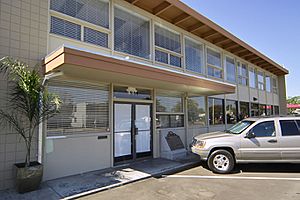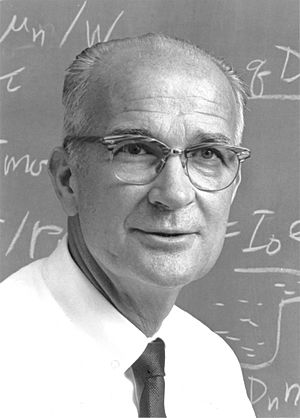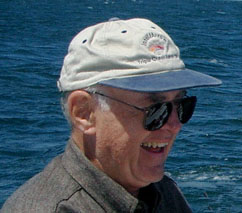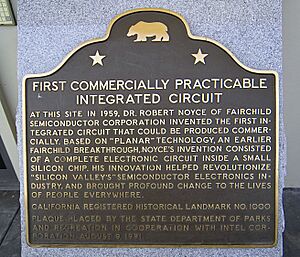Traitorous eight facts for kids
The Traitorous Eight were a group of eight smart scientists and engineers who left a company called Shockley Semiconductor Laboratory in 1957. They decided to start their own company, which became very famous: Fairchild Semiconductor.
Their boss, William Shockley, had won a Nobel Prize for his work on transistors. He hired these young scientists to create new electronic devices. However, Shockley was a very strict boss, and his ideas for new products weren't working out. Because of his difficult management style, the eight scientists decided to leave and build their own future.
Shockley called their leaving a "betrayal." The eight people were Julius Blank, Victor Grinich, Jean Hoerni, Eugene Kleiner, Jay Last, Gordon Moore, Robert Noyce, and Sheldon Roberts. In August 1957, they teamed up with a businessman named Sherman Fairchild. On September 18, 1957, they officially started Fairchild Semiconductor. This new company quickly became a leader in the world of electronics.
By 1960, Fairchild Semiconductor was a key part of what we now call Silicon Valley. Many new companies, like Intel and AMD, were started by people who had worked at Fairchild. These companies are often called "Fairchildren."
Contents
How it All Started
In 1954, William Shockley, who helped invent the transistor, wanted to start making advanced transistors and special devices called Shockley diodes. He found a supporter in Arnold Beckman, who owned Beckman Instruments. Shockley needed a lot of money, about one million dollars. Beckman knew Shockley might not be great at business, but he believed Shockley's inventions could help his own company. So, Beckman agreed to fund a new lab.
The new lab was part of Beckman Instruments and was named Shockley Semi-Conductor Laboratories. They bought licenses for important patents and chose a location in Mountain View, near Palo Alto, California. Most experts in electronics were on the East Coast, so Shockley advertised in newspapers to find new employees. Many talented people, including Gordon Moore and Robert Noyce, joined his team.
Shockley believed in special tests for hiring. He asked each person to take a psychological test before an interview.
The eight future founders started joining the lab in 1956. By September 1956, the lab had 32 employees. Each person negotiated their salary with Shockley. Shockley even made all salaries public, which was unusual.
The "Traitorous Eight" were all quite young, between 26 and 33 years old. Six of them had advanced degrees, like PhDs. Only Robert Noyce had worked with semiconductors before, and only Victor Grinich had experience in electronics.
What They Worked On
In 1956, most of the lab members were setting up equipment. Scientists like Jean Hoerni and Robert Noyce did their own research. Shockley didn't want to hire technical staff, believing his scientists should do everything. He focused on making Shockley diodes for mass production.
Shockley decided not to work on another type of transistor called bipolar transistors. This turned out to be a big mistake later on. The Shockley diodes they made didn't sell well.
Some people believe Shockley changed his mind about what to work on. He might have seen his diode as a more interesting science problem, even if it wasn't good for business. Other experts say that Shockley diodes were always the main goal for the lab.
Problems at the Lab
Many historians and colleagues agree that Shockley was not a good manager. He often got angry and saw rivals everywhere, even among his own team.
In November 1956, Shockley won the Nobel Prize. This was a big deal, but it also took him away from the lab when it was having problems. The atmosphere in the lab was not good.
Shockley didn't trust his employees. He recorded phone calls and didn't let staff share their work with each other. He even sent their reports to another company to be checked. At one point, he wanted everyone to take a lie detector test, but they all refused.
People started leaving the team. Robert Noyce and Gordon Moore had different ideas about how to handle things. Moore led the group who wanted to leave, while Noyce tried to help Shockley solve the problems. Shockley thought Noyce was his only supporter.
Leaving Shockley Labs
In March 1957, Eugene Kleiner, who Shockley trusted, secretly went to New York to find investors for a new company. He had the support of Blank, Grinich, Last, Roberts, Hoerni, and Moore. Two investors, Arthur Rock and Alfred Coyle, were interested. They believed that people trained by a Nobel Prize winner would surely succeed.
As a last try, on May 29, 1957, the group led by Moore told Arnold Beckman that he needed to fix the "Shockley problem" or they would leave. Moore suggested that Shockley could teach at a university and a professional manager could run the lab. Beckman refused, which he later regretted.
In June 1957, Beckman finally put a manager in charge, but by then, seven key employees had already decided to leave. At the last moment, Robert Noyce joined them. These ten people became the core of the new company.
Coyle, a ruddy-faced Irishman with a fondness for ceremony, pulled out 10 newly minted $1 bills and laid them carefully on the table. "Each of us should sign every bill", he said. These dollar bills, covered with signatures, he explained, would be their contracts with each other.
Finding investors was hard because most electronics companies were on the East Coast, but the group wanted to stay in California. In August 1957, they met Sherman Fairchild, who owned Fairchild Aircraft. Fairchild agreed to help. The new company, Fairchild Semiconductor, got a loan of $1.38 million. Each of the eight founders received 100 shares in the company.
On September 18, 1957, Blank, Grinich, Kleiner, Last, Moore, Noyce, Roberts, and Hoerni officially resigned from Shockley Labs. They became known as the "Traitorous Eight." Shockley never understood why they left. He never spoke to Noyce again but kept an eye on their work.
In 1960, Shockley finally got his diode into production, but it was too late. Other companies were already working on more advanced technologies. Beckman sold the lab, and after a car crash, Shockley left the company to teach at Stanford. The lab eventually closed down.
Fairchild Semiconductor's Growth

We were all focused on the single goal of producing our first product, a double diffused silicon mesa transistor ... We were all very young (27 to 32), only a few years beyond our school days. We were a very compatible group and spent a lot of time outside our working hours. Most of the founders were married, busy starting their families and raising small children in addition to all the time and effort they were spending building Fairchild ... I am struck by what a remarkable time it was and what innovative opportunities. – Jay T. Last, 2010
In November 1957, the Eight moved from Victor Grinich's garage into a new building. Their starting salaries were good, ranging from $13,800 to $15,600 per year. Robert Noyce and Gordon Moore became the main leaders in research and production.
The group quickly set a goal: to make special silicon transistors for digital devices. They used ideas from Bell Labs and Shockley Labs. Gordon Moore, Jean Hoerni, and Jay Last led teams working on different technologies. Moore's technology worked best, and by mid-1958, they started mass production of their transistors. This success made Fairchild Semiconductor very famous.
In 1958, Fairchild's transistors were considered for a military computer, but they weren't reliable enough. Fairchild had a solution: Jean Hoerni's "planar technology." This new technology was a huge step forward in microelectronics, almost as important as the invention of the transistor itself. Fairchild announced this new technology in October 1960.
In 1959, Sherman Fairchild bought shares from the founders. Jay Last felt this changed things, making them feel more like regular employees. In 1961, Last and Hoerni left Fairchild to start a new company called Amelco. Kleiner and Roberts joined them a few weeks later. This meant the original "Traitorous Eight" split into two groups of four. Blank, Grinich, Moore, and Noyce stayed with Fairchild.
Their Legacy
From 1960 to 1965, Fairchild was the top company in the semiconductor market. But by 1965, they started having management problems. Many top managers left for other companies. In 1967, the company started losing money and lost its leading position.
In March 1968, Gordon Moore and Robert Noyce decided to leave Fairchild. They again turned to Arthur Rock, the investor. In the summer of 1968, they founded a new company called NM Electronics. The other original members of the Traitorous Eight, even with past disagreements, supported Moore and Noyce financially. A year later, NM Electronics changed its name to Intel. Gordon Moore held important positions at Intel until 1997. Robert Noyce left Intel in 1987 and passed away in 1990.
Victor Grinich left Fairchild in 1968 and later taught at UC Berkeley and Stanford. He wrote the first complete textbook on integrated circuits. He also helped start companies that developed radio-frequency identification tags.
Julius Blank was the last of the Eight to leave Fairchild in 1969. He started a financial company called Xicor, which focused on new technology companies. He sold it for a lot of money in 2004.
Jean Hoerni led Amelco for a while. In 1967, he started Intersil, a company that made special electronic circuits. These circuits helped make Japanese electronic watches popular in the late 1960s. Intersil and Intel weren't competitors because they focused on different types of circuits and markets.
Jay Last stayed with Amelco for twelve years. He later founded a company that published art books. Sheldon Roberts also started his own business after leaving Amelco.
In 1972, Eugene Kleiner and Tom Perkins started a very successful investment fund called Kleiner Perkins Caufield & Byers. This fund helped create or fund many famous companies like Amazon.com, Compaq, and Genentech. Kleiner wanted to spread venture financing to more places.
Awards and Recognition
In May 2011, the California Historical Society gave the "Legends of California Award" to The Eight. Julius Blank, Jay Last, Gordon Moore, and Sheldon Roberts' son attended the event.
The "Fairchildren"
The term "Fairchildren" is used in different ways when talking about Silicon Valley:
- It can mean the new companies started by former employees of Fairchild Semiconductor.
- It can also refer to the founders of these new companies.
- Sometimes, it means any former employee of Fairchild Semiconductor.
- And sometimes, it even refers to the original founders of Fairchild Semiconductor, the "Traitorous Eight" themselves.
One of the first articles to point out how many companies came from Fairchild was in Innovation Magazine in 1969. Companies like AMD, Intel, and Intersil were different from older electronics companies. Their founders aimed to sell shares to the public quickly. Another key thing about Silicon Valley was how easily managers and professionals moved between companies. People were loyal to each other, but not always to one employer. You can find former Fairchild employees in many different types of companies today.
See also
 In Spanish: Los niños de Fairchild para niños
In Spanish: Los niños de Fairchild para niños




